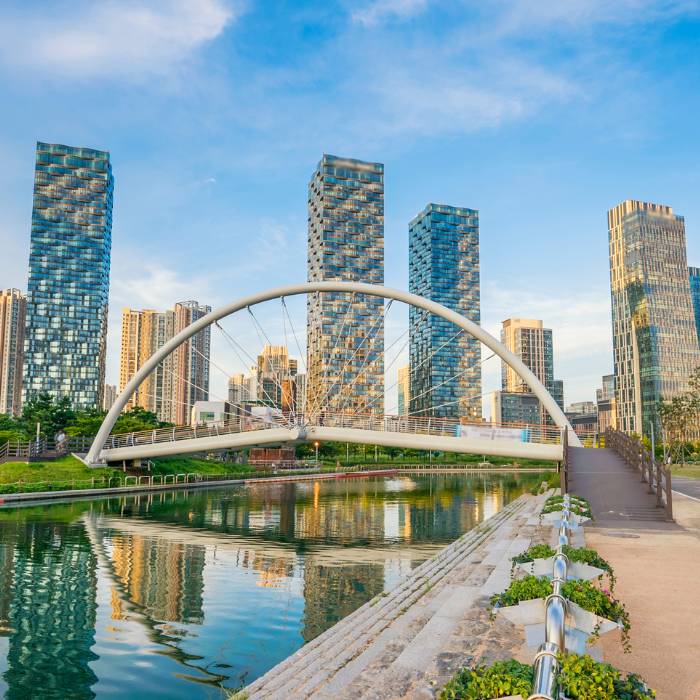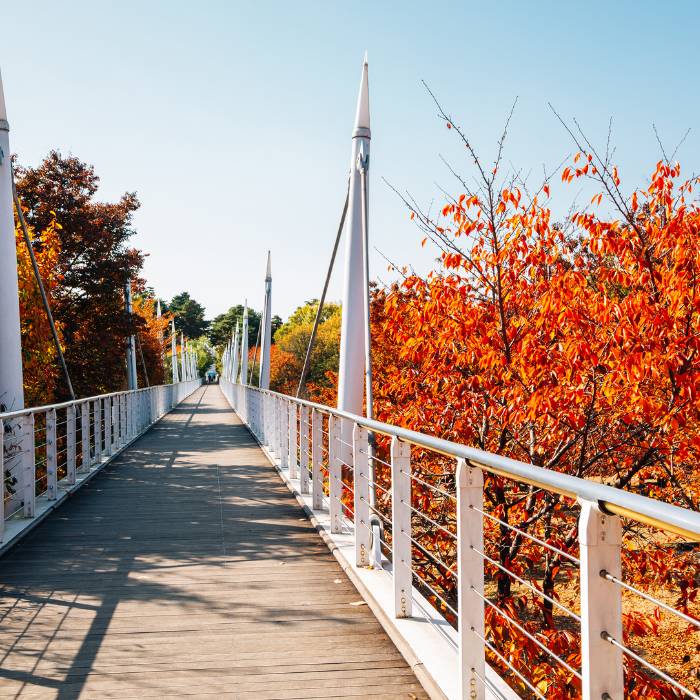Seoul Forest Park is a must-visit destination for travelers seeking a blend of nature, culture, and community in South Korea’s bustling capital. Located in Seongdong-gu, this sprawling urban park, opened in 2005, covers approximately 1.16 million square meters (289 acres), offering a serene escape from the city’s fast pace. Whether you’re a nature lover, culture enthusiast, or family traveler, Seoul Forest has something for everyone. This guide introduces the park’s highlights, seasonal events, and practical tips to make your visit unforgettable.
Why Visit Seoul Forest Park?
Seoul Forest is more than just a park—it’s a vibrant community hub where nature and culture intertwine. With five distinct zones, diverse wildlife, and year-round events, it’s a place where you can relax, explore, and connect. Here’s what makes it special:
1. Five Unique Zones
Seoul Forest is divided into five themed areas, each offering a unique experience:
- Cultural Art Park: Features an outdoor stage and exhibition spaces hosting concerts, art displays, and performances.
- Ecological Forest: A haven for wildlife like deer, squirrels, and pheasants, with wetlands and ponds perfect for nature observation.
- Nature Experience Learning Center: Ideal for families, offering hands-on educational programs and workshops for kids.
- Han River Waterfront Park: Scenic walking and cycling paths along the Han River for leisurely strolls or exercise.
- Sports and Amenities: Equipped with playgrounds, picnic areas, and trails for outdoor activities.

2. A Nature Lover’s Paradise
Seoul Forest is home to diverse flora and fauna, with seasonal blooms like cherry blossoms in spring and vibrant foliage in autumn. The park’s ecological focus allows visitors to immerse themselves in nature while still being in the heart of Seoul.
3. Year-Round Events and Festivals
Seoul Forest is a hub for exciting events that draw locals and tourists alike. From jazz festivals to eco-workshops, there’s always something happening. Highlights include:
- Spring (March-May): Spring transforms Seoul Forest into a floral wonderland, with cherry blossoms and tulips in full bloom. The Cherry Blossom Festival (typically early April) draws crowds for its stunning views along the Cherry Blossom Path and Seoul Forest Plaza. Expect cultural performances like traditional Korean music, food stalls serving seasonal treats like hotteok (sweet pancakes), and family-friendly activities such as kite-flying and face-painting. The Tulip Festival in the Bulb Garden features vibrant displays of over 200 tulip varieties, photography contests, and guided tours explaining the park’s flora. These events create a festive atmosphere perfect for picnics under blooming trees
- Summer (June-August): Summer brings lush greenery and vibrant flowers like yellow irises and peonies. The park hosts Hydrangea Garden Workshops in the Hydrangea Garden, where visitors can learn about these colorful blooms, create floral crafts, or join gardening classes. For families, the Water Play Events at the Cultural Art Park’s ground fountain offer a refreshing escape, with kids splashing in timed water sessions (daily from 12 PM to 4 PM in July-August). Evening concerts, often featuring local indie bands or acoustic performances, take place in the Cultural Art Park, paired with food trucks serving churros and iced drinks. Spontaneous activities like outdoor yoga or sketching sessions also pop up, adding to the relaxed summer vibe.
- Autumn (September-November): Autumn is a highlight with the Seoul Forest Jazz Festival (typically September or October), a major event featuring local and international jazz artists performing on outdoor stages. Visitors enjoy live music, food trucks offering gourmet snacks, and pop-up markets selling handmade crafts. The festival’s laid-back atmosphere, set against golden ginkgo trees and metasequoia paths, makes it a favorite for music lovers. Additionally, BioBlitz Events engage eco-enthusiasts in citizen-science activities, where participants join experts to survey the park’s biodiversity, identifying plants, insects, and birds. Autumn also features photography walks to capture the vibrant foliage, especially in the Ginkgo Tree Forest.
- Winter (December-February): Winter brings a magical charm with the WINTERLIGHTS Media Exhibition (December to January), a highlight at the Family Courtyard. This immersive display features 80,000 interactive LEDs and sound installations around 200 upside-down Christmas trees, creating a fairy-tale atmosphere crafted by German artist Christopher Bauder. Visitors can also join Winter Ecology Tours, guided walks exploring the park’s winter flora and fauna, such as migratory birds. For families, craft workshops at the Nature Experience Learning Center offer activities like making pine wreaths or eco-friendly ornaments, fostering a cozy, festive spirit.
For the latest event schedules, check the official website: Seoul Forest Park.
4. Community-Driven Spirit
Since its opening, Seoul Forest has been shaped by citizen involvement. Over 100,000 volunteers have contributed to its maintenance and programs, making it a true community space. Visitors can join workshops like gardening classes, ecological surveys (e.g., BioBlitz), or even fan-organized events, such as K-pop fandom gatherings.

Top Things to Do in Seoul Forest
- Stroll Through Nature: Wander the trails to spot wildlife or enjoy seasonal flowers like tulips, hydrangeas, or maples.
- Attend a Festival: Plan your visit around events like the Seoul Forest Jazz Festival or seasonal garden exhibitions.
- Cycle Along the Han River: Rent a bike and explore the scenic waterfront paths.
- Join a Workshop: Participate in gardening, ecology, or art programs for a hands-on experience.
- Relax with a Picnic: Bring a blanket and enjoy a meal in one of the park’s open spaces.
Practical Tips for Visiting
- Rules: No tents, drones, or unleashed pets to protect the park’s ecosystem.
- Location: Seongdong-gu, Seoul (near Ttukseom Island).
- Access: Easily reachable via subway—Seoul Forest Station (Bundang Line, Exit 2) or Ttukseom Station (Line 7, Exit 8).
- Admission: Free.
- Hours: Open 24/7, though some facilities have specific hours.
- Best Time to Visit: Spring for cherry blossoms, autumn for foliage and festivals.
- What to Bring: Comfortable shoes, picnic supplies, and a camera for stunning views.
- Parking: Limited; public transport is recommended.
2025 Special Events to Watch For
Seoul Forest is gearing up for a big year in 2025, marking its 20th anniversary since opening in 2005. Expect special celebrations, possibly including a large-scale festival or citizen-led campaigns. Additionally, the park may host events tied to the Seoul International Garden Expo (May-October 2025, Ttukseom Han River Park), featuring garden workshops and pop-up displays. Smaller events like fan-organized gatherings, ecological programs, and seasonal markets will continue year-round. For the latest event schedules and detailed information, visit the official website: Seoul Forest Park.
Plan Your Visit Today
Seoul Forest Park is a perfect blend of nature, culture, and community, offering something for every traveler. Whether you’re exploring its ecological trails, enjoying a jazz concert, or joining a gardening workshop, the park promises a memorable experience. With events happening every season, it’s worth checking the calendar to align your visit with a festival or program. Pack your walking shoes, grab a picnic, and discover the green heart of Seoul!